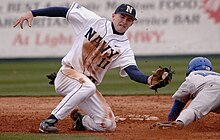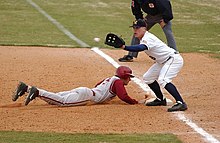Comparison of baseball and cricket
[citation needed] Despite their similarities, the two sports also have many differences in play and in strategy; for example, far more runs are scored in a cricket match compared to a baseball game.
[2] A comparison between baseball and cricket can be instructive to followers of either sport, since the differences help to highlight nuances particular to each game.
[3] In both cricket and baseball, the players of one team attempt to score points known as runs by hitting a ball with a bat and running, while the members of the other team field the ball in an attempt to prevent scoring and to put batting players out.
[61] Left-handers and right-handers in fielding: Body contact between runner and fielder is frequent in baseball, particularly at home plate.
Similarly, there are many kinds of pitches thrown, including the fastball, curve ball, slider, and knuckleball.
The number of pitchers/bowlers on a team: The prevalence of batters occasionally doing some pitching, even when they are weak at it: The way that each delivery has an impact in advancing the game: One of the main differences between baseball and Test cricket is the primary intent of the batsman.
The runner may also deliberately slide into the fielder at the base he is trying to steal to keep him from catching the ball or to disrupt a double play.
The equivalent in cricket is almost impossible because the bowler is next to the non-striker, and in fact is able to mankad him if he strayed out of his crease (or simply cancel his runup, rendering the ball dead); in addition, it is legally considered unfair play for the batsmen to steal runs during the bowler's runup.
While in baseball, steals, sacrificial running, forces, double plays, intimidation, and physical contact enter into the equation.
[132][133] Cricket uses the Umpire Decision Review System (DRS for short), while there is Instant replay in Major League Baseball.
Full length games, for example between English counties or between Australian states, have a similar format to Test matches, but either three or four days are allowed.
One Day Internationals and Twenty20 cricket, with their inherent limit on the number of fair deliveries, do not have an exact equivalent in baseball.
It is possible to place a close-in fielder to catch a bunt, but this practice is almost never followed except in specialised circumstances such as a pitcher being forced to bat late in a game, with less than two outs and the opportunity to drive in a run.
The team's best chance to score in such a situation may be to sacrifice bunt and may warrant the first or third baseman playing halfway up the line to cut off the run at home.
These are plays in which a batter deliberately hits in a particular way or in a particular direction to advance runner(s) at the expense of himself getting out.
Note that in amateur cricket pitches may have considerable variation in shape and may even incorporate obstacles (like tree roots), but this is not considered desirable or ideal.
In baseball, familiarity with distinct field layout is considered to be an important part of having home-field advantage.
Sacrifice plays: How the fielding team can negate the influence of a skilled batter: Here are two examples of the scoreboard from one of the sports transferred to the other, to demonstrate what types of information both convey (the examples are designed for situations where there is greater ambiguity): Notation: "xxx" means that a piece of information isn't transferred to the other sport, while "?"
Conclusions are sometimes drawn from inadequate samples – for example, an assertion that a batter has done poorly against a specific pitcher, when they have only faced each other a handful of times, or that a player is "clutch" due to having more success with runners in scoring position or during the late innings with rather small sample sizes.
The history of baseball's formation and rise in popularity took place in the originally more cricket-supporting societies of England and America.
[197] However, cricket had still been popular enough that President Abraham Lincoln had watched two American cities play each other in the sport in the years before the war.
This helped to cement cricket as part of the national culture of several countries that later won their independence from the British.
[197] Later on, the T10 format of cricket, in which games last less than two hours, emerged at a domestic level, with leagues being started for it in several major cricket-playing countries.
[203][204] Don Bradman was a famous cricket batsman who was known for his childhood drill of hitting a golf ball with a stump, which many consider to have significantly improved his hand-eye coordination.













